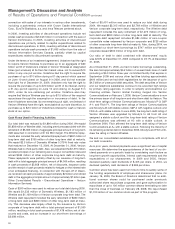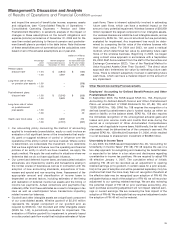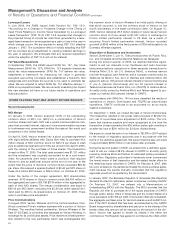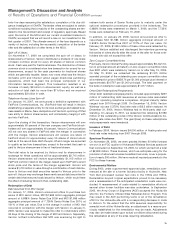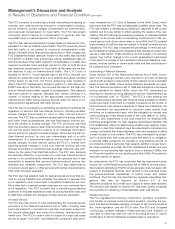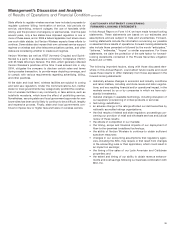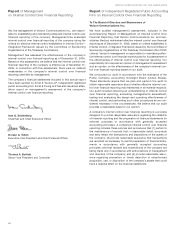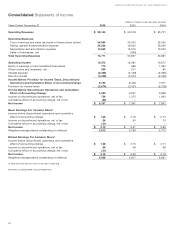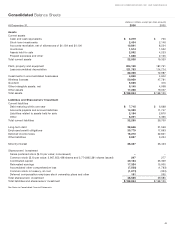Verizon Wireless 2006 Annual Report Download - page 35
Download and view the complete annual report
Please find page 35 of the 2006 Verizon Wireless annual report below. You can navigate through the pages in the report by either clicking on the pages listed below, or by using the keyword search tool below to find specific information within the annual report.
cash flows. There is inherent subjectivity involved in estimating
future cash flows, which can have a material impact on the
amount of any potential impairment. Wireless licenses of $50,959
million represent the largest component of our intangible assets.
Our wireless licenses are indefinite-lived intangible assets, and as
required by SFAS No. 142, are not amortized but are periodically
evaluated for impairment. Any impairment loss would be deter-
mined by comparing the fair value of the wireless licenses with
their carrying value. For 2004 and 2003, we used a residual
method, which determined fair value by estimating future cash
flows of the wireless business. Beginning in 2005, we began
using a direct value approach in accordance with a September
29, 2004 Staff Announcement from the staff of the Securities and
Exchange Commission (SEC), “Use of the Residual Method to
Value Acquired Assets Other Than Goodwill.” The direct value
approach also determines fair value by estimating future cash
flows. There is inherent subjectivity involved in estimating future
cash flows, which can have a material impact on the amount of
any impairment.
Other Recent Accounting Pronouncements
Employers’ Accounting for Defined Benefit Pension and Other
Postretirement Plans
In September 2006, the FASB issued SFAS No. 158, Employers’
Accounting for Defined Benefit Pension and Other Postretirement
Plans—an amendment of FASB Statements No. 87, 88, 106, and
132(R) (SFAS No. 158). SFAS No. 158 requires the recognition of a
defined benefit postretirement plan’s funded status as either an
asset or liability on the balance sheet. SFAS No. 158 also requires
the immediate recognition of the unrecognized actuarial gains and
losses and prior service costs and credits that arise during the
period as a component of Other Accumulated Comprehensive
Income, net of applicable income taxes. Additionally, the fair value of
plan assets must be determined as of the company’s year-end. We
adopted SFAS No. 158 effective December 31, 2006, which resulted
in a net decrease to shareowners’ investment of $6,883 million.
Uncertainty in Income Taxes
In July 2006, the FASB issued Interpretation No. 48, “Accounting for
Uncertainty in Income Taxes” (FIN 48). FIN 48 requires the use of a
two-step approach for recognizing and measuring tax benefits taken
or expected to be taken in a tax return and disclosures regarding
uncertainties in income tax positions. We are required to adopt FIN
48 effective January 1, 2007. The cumulative effect of initially
adopting FIN 48 will be recorded as an adjustment to opening
retained earnings (or to goodwill, in certain cases for a prior acquisi-
tion) in the year of adoption and will be presented separately. Only tax
positions that meet the more likely than not recognition threshold at
the effective date may be recognized upon adoption of FIN 48. We
anticipate that as a result of the adoption of FIN 48, we will record an
adjustment to our opening retained earnings. We are also reviewing
the potential impact of FIN 48 on prior purchase accounting. Any
such purchase accounting adjustment will not impact retained earn-
ings or current earnings. We are reviewing the final impact of the
adoption of FIN 48. We anticipate that any required adjustment under
the adoption of FIN 48 will not be material.
and impact the amount of benefit plan income, expense, assets
and obligations (see “Consolidated Results of Operations –
Consolidated Operating Expenses – Pension and Other
Postretirement Benefits”). A sensitivity analysis of the impact of
changes in these assumptions on the benefit obligations and
expense (income) recorded as of December 31, 2006 and for the
year then ended pertaining to Verizon’s pension and postretire-
ment benefit plans is provided in the table below. Note that some
of these sensitivities are not symmetrical as the calculations were
based on all of the actuarial assumptions as of year-end.
(dollars in millions)
Expense
Percentage Benefit obligation increase (decrease)
point increase (decrease) at for the year ended
change December 31, 2006 December 31, 2006
Pension plans
discount rate + 1.00 $ (3,844) $ (130)
- 1.00 4,597 266
Long-term rate of return
on pension plan assets + 1.00 – (378)
- 1.00 – 378
Postretirement plans
discount rate + 1.00 $ (3,245) $ (209)
- 1.00 3,693 236
Long-term rate of return
on postretirement
plan assets + 1.00 – (40)
- 1.00 – 40
Health care trend rates + 1.00 3,339 472
- 1.00 (2,731) (357)
•Our accounting policy concerning the method of accounting
applied to investments (consolidation, equity or cost) involves an
evaluation of all significant terms of the investments that explic-
itly grant or suggest evidence of control or influence over the
operations of the entity in which we have invested. Where control
is determined, we consolidate the investment. If we determine
that we have significant influence over the operating and financial
policies of an entity in which we have invested, we apply the
equity method. We apply the cost method in situations where we
determine that we do not have significant influence.
•Our current and deferred income taxes, and associated valuation
allowances, are impacted by events and transactions arising in
the normal course of business as well as in connection with the
adoption of new accounting standards, acquisitions of busi-
nesses and special and non-recurring items. Assessment of the
appropriate amount and classification of income taxes is
dependent on several factors, including estimates of the timing
and realization of deferred income tax assets and the timing of
income tax payments. Actual collections and payments may
materially differ from these estimates as a result of changes in tax
laws as well as unanticipated future transactions impacting
related income tax balances.
•Goodwill and other intangible assets are a significant component
of our consolidated assets. Wireline goodwill of $5,310 million
represents the largest component of our goodwill and, as
required by SFAS No. 142, Goodwill and Other Intangible Assets
(SFAS No. 142), is periodically evaluated for impairment. The
evaluation of Wireline goodwill for impairment is primarily based
on a discounted cash flow model that includes estimates of future
33
Management’s Discussion and Analysis
of Results of Operations and Financial Condition continued









